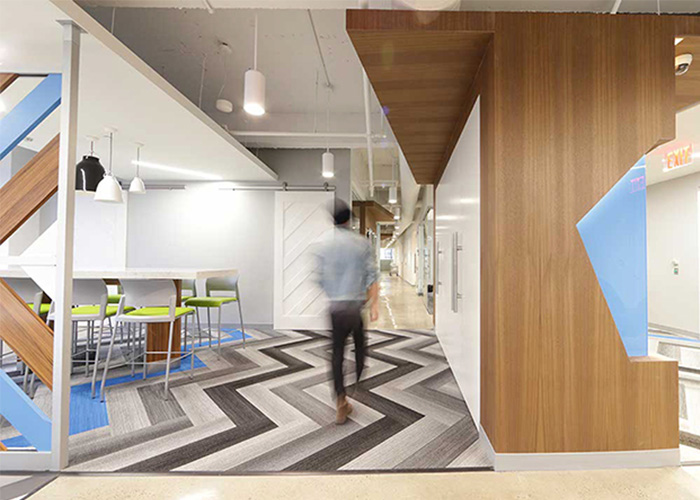
“A physical space is the body language of an organization – with its own grammar that can be tweaked and modified to produce desirable habits.” That’s what the authors of Make Space believe, and that’s the philosophy that Shive-Hattery follows as well.
This “body language” also helps shape an organization’s brand, culture, and community. The work environment has never been more important – or under such a large microscope – as it is now. Unemployment rates continue to stay low, and organizations are competing for the same talent. For this reason, employees are turning down jobs due to their workspace – and employees are leaving jobs to work for organizations that offer more energized, creative, and productive space. HR directors tell me it’s not unusual for a job candidate to walk through a workspace and say, “I can’t imagine myself working here” – even before learning about salary, benefits, or any other perks.
When talking about collaborative and energized workplaces, Google’s story is often front and center, but your organization doesn’t have to be a tech company to create its own corporate culture. Successful organizations of all types are taking steps toward creating environments that attract new employees, make existing employees happier and more productive, and foster collaboration and community building.
What’s driving this trend? Today’s pace of work and interaction. Several years ago, workplaces supported employees who were responsible for completing one or two specific tasks. Now, it’s not uncommon for one employee to be working on several tasks simultaneously – often a mix of heads-down and collaborative work. Spaces that supported our work 25 years ago are struggling to support today’s rapid workstyle and pace.
Here are some simple things you can do to create environments that help attract, recruit, and retain talent in this competitive environment.
1. Give People Choices
How do we make the workplace an environment where people want to be – not just a place they have to be? To improve retention, a Fortune 50 healthcare insurance company gave its employees choices about their workspaces.
After performing well for a certain period of time (six months, for example), employees were given the choice to work from home during part of the week. This reduced dedicated desk space requirements, allowing the company to cut real estate costs and make better use of the square footage they had by creating different workplace options.
Employees in the office are given choices in terms of where and how to work – and those choices go beyond personal workspace. For example, relaxation zones were designed to allow call-center employees to decompress by stepping away from the intensity of being on the phone all day. Collaboration areas give employees a chance to meet in small groups to work through challenges. Enclosed spaces are also available for workers who need to focus in order to complete heads-down tasks.
Offering a variety of workplace choices empowers employees to make their own decisions about what best suits their workstyles.
2. Align Design with Company Culture
Highly collaborative workplaces don’t automatically mean ping pong tables and putting greens. Design features and amenities work best when a company’s culture and values support it, just like with any design decision. It’s never a one-size-fits-all solution, and there are always ways to create workplaces that reflect your organization’s unique culture.
Incorporating a collaborative zone with a variety of seating options – including couches by the windows – only enhances idea generation and collaboration when company culture backs it. If managers believe that sitting on sofas leads to work not being done, then employees won’t feel comfortable using the space as intended.
At Grubhub, an online and mobile food ordering company, leadership knew that existing employees valued feelings of community, networking, and belonging. Many employees had formed groups based on interests: cooking clubs, book clubs, garden clubs, etc. To foster this interaction (because great ideas can spark anytime, anywhere), Grubhub incorporated kitchens, reading nooks, and rooftop decks into its space. Creating a sense of community within the workplace is one of the best ways an employer can build a positive culture and improve employee engagement.
The main floor also includes 15,000 square feet of game-room space, including a vintage bar and lounge area with pool tables and shuffleboards. This not only provides a place to foster positive employee interaction, but also allows Grubhub to host events and show potential employees more about the company.
3. Focus on Wellness
From sit/stand workstations to promoting movement throughout the day, incorporating employee wellness into workplace design doesn’t just benefit employees – it benefits the entire organization. Healthy employees come to work more often, are in better moods, and are focused and productive.
Sometimes it’s as simple as placing printers and recycling receptacles in a central location to encourage walking. Other times, it can mean employee access to service stations with healthy snacks and lunches. It all depends on the organization.
At RSM, private offices were given glass walls and then moved away from the window line. This change turned the once-cavernous workspace into a lighter, brighter area. Employees located in open workstations now have direct access to daylight and views that offer a connection to nature and time of day. Based on the smiles on employees’ faces, the results were evident: Letting in more daylight helped energize employees and reduce fatigue.
When designing your workplace to reinforce your existing culture – or as a catalyst for change – one thing is certain: A combination of leadership support, employee engagement, and understanding is what ultimately leads to success.
Stay in Touch for Monthly Shive-Hattery Industry Insights

